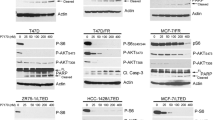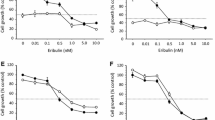Abstract
MA is an orally active PG derivative with an excellent safety profile that is used primarily for the treatment of carcinomas of the breast and endometrium. We investigated the potential application of MA as an MDR-reversal agent using cell culture and human tumor xenograft models. The reversing activity of MA in vitro was compared with that of PG and VER in two human MDR cell lines, the colon carcinoma HCT-116/VM46 and the breast carcinoma MCF-7/ADR, and in a murine cell line, J774.2. At concentrations as low as 3 μM, MA was capable of partially restoring sensitivity to Act D in the HCT-116/VM46 cells and sensitivity to DOX in the MCF-7/ADR cells. Although less effective than VER, MA was about 2.5 times more potent than PG in reversing MDR at equimolar concentrations. Increased accumulation of DOX in drugresistant cells that were treated simultaneously with MA was observed by flow cytometry. In vivo, using established human colon and breast carcinoma xenografts implanted s.c. in athymic mice, the combined therapy with MA and DOX resulted in enhanced antitumor activity relative to that of DOX alone in the MDR sublines. These results suggest that MA may be a promising clinical MDR-reversing agent.
Similar content being viewed by others
Abbreviations
- Act D:
-
actinomycin D
- DOX:
-
doxorubicin
- PG:
-
progesterone
- MA:
-
megestrol acetate
- VER:
-
verapamil
- VBL:
-
vinblastine
- MDR:
-
multidrug resistance
- P-gp:
-
P-glycoprotein
- MAP:
-
medroxyprogesterone acetate
- MTD:
-
maximum tolerated dose
- q4dx3:
-
every 4 days for 3 treatments
- TVDD:
-
tumor volume-doubling time
- IC50 :
-
drug concentration producing 50% cell kill in treatéd cultures as compared with controls
- PBS:
-
phosphate-buffered saline
- VM-26:
-
teniposide
References
Abrams JS, Parnes H, Aisner J (1990) Current status of high-dose progestins in breast cancer. Semin Oncol 17: 68–72
Bellamy WT, Dalton WS, Dorr RT (1990) The clinical relevance of multidrug resistance. Cancer Invest 8: 547–562
Beck WT (1990) Multidrug resistance and its circumvention. Eur J Cancer 26: 513–515
Begg AC (1987) Principles and practices of the tumor growth delay assay. In: Kallman RF (ed) Rodent tumor models in experimental cancer therapy. Pergamon, New York, pp 114–121
Benard J, Bourhis J, Riou G (1990) Clinical significance of multiple drug resistance in human cancers. Anticancer Res 10: 1297–1302
Bourhis J, Benard J, Hartmann O, Boccon-Gibod L, Lemerle J, Riou G (1989) Expression of multidrug resistance gene: MDR1 correlates with chemotherapy in neuroblastoma. J Natl Cancer Inst 81: 1401–1405
Bradley G, Juranka PF, Ling V (1988) Mechanism of multidrug resistance. Biochim Biophys Acta 948: 87–128
Bruno NA, Slate DL (1990) Effect of exposure to calcium entry blockers on doxorubicin accumulation and cytotoxicity in multidrug-resistant cells. J Natl Cancer Inst 82: 419–424
Chan HSL, Thorner PS, Haddad G, Ling V (1990) Immunohistochemical detection of P-glycoprotein: prognostic correlation in soft tissue sarcoma of childhood. J Clin Oncol 8: 689–704
Chan HSL, Haddad G, Thorner PS, DeBoer G, Lin YP, Ondrusek N, Yeger H, Ling V (1991) P-glycoprotein expression as a predictor of the outcome of therapy for neuroblastoma. N Engl J Med 325: 1608–1614
Dalton WS, Grogan TM, Meltzer PS, Scheper RJ, Durie BGM, Taylor CW, Miller TP, Salmon SE (1989) Drug-resistance in multiple myeloma and non-Hodgkin's lymphoma: detection of P-glycoprotein and potential circumvention by addition of verapamil to chemotherapy. J Clin Oncol 7: 415–424
Endicott JA, Ling V (1989) The biochemistry of P-glycoproteinmediated multidrug resistance. Ann Rev Biochem 58: 137–171
Fairchild C, Ivy S, Kao-Shan C, Whang-Peng J, Rosen N, Istrael M, Melera P, Cowan K, Goldsmith M (1987) Isolation of amplified and overexpressed DNA sequences from Adriamycin-resistant human breast cancer cells. Cancer Res 47: 5141–5148
Fleming GF, Amato JM, Agresti M, Agresti M, Safa AM (1992) Megestrol acetate reverses multidrug resistance and interacts with P-glycoprotein. Cancer Chemother Pharmacol 29: 445–449
Ford JM, Hait W (1990) Pharmacology of drugs that alter multidrug resistance in cancer. Pharmacol Rev 42: 155–199
Gaver RC, Pittman KA, Reilly CM (1985) Bioequivalence evaluation of new megestrol acetate formulations in humans. Semin Oncol 12: 17–19
Georges E, Sharom FJ, Ling V (1990) Multidrug resistance and chemosensitization: therapeutic implications for cancer chemotherapy. Adv Pharmacol 21: 185–220
Haves JD, Wolf CR (1990) Molecular mechanisms of drug resistance. Biochem J 272: 281–295
Hsu SI-H, Lothstein L, Horwitz SB (1989) Differential overexpression of the threemdr gene family members in multidrugresistant J 774.2 mouse cells. J Biol Chem 264: 12053–12062
Kalken CK van, Hoeven JJM van der, Jong J de, Giaccone G, Schuurhuis GJ, Maessen PA, Blokhuis WMD, Vijgh WJF van der, Pinedo HM (1991) Bepridil in combination with anthracyclines to reverse anthracycline resistance in cancer patients. Eur J Cancer 27: 739–744
Kuwazuru Y, Yoshimura A, Hanada S, Utsunomiya A, Makino T, Ishibashi K, Kodama M, Iwahashi M, Arima T, Akiyama S-I (1990) Expression of the multidrug transporter, p-glycoprotein, in acute leukemia cells and correlation to clinical drug resistance. Cancer 66: 868–873
Long BH, Wang L, Lorico A, Wang R, Brattain MG, Casazza AM (1991) Mechanisms of resistance to etoposide and teniposide in acquired resistant human colon and lung carcinoma cell lines. Cancer Res 51: 5275–5284
Loprinzi CL, Ellison NM, Schaid DJ, Krook JE, Athmann LM, Dose AM, Mailliard JA, Johnson PS, Ebbert LP, Geeraerts LH (1990) Controlled trial of megestrol acetate for the treatment of cancer anorexia and cachexia. J Natl Cancer Inst 82: 1127–1132
Miller AA, Becher R, Schmidt CG (1988) Plasma concentrations of medroxyprogesterone acetate and megesterol acetate during long-term follow-up in patients treated for metastatic breast cancer. J Cancer Res Clin Oncol 114: 186–190
Miller RL, Bukowski RM, Budd GT, Purvis J, Weick JK, Shepard K, Midha KK, Ganapathi R (1988) Clinical modulation of doxorubicin resistance by the calmodulin-inhibitor, trifluoperazine: a phaseI/II trial. J Clin Oncol 6: 880–888
Miller TP, Grogan TM, Dalton WS, Spier CM, Scheper RJ, Salmon SE (1991) P-glycoprotein expression in malignant lymphoma and reversal of clinical drug resistance with chemotherapy plus high-dose verapamil. J Clin Oncol 9: 17–24
Naito M, Yusa K, Tsuruo T (1989) Steriod hormones inhibit binding of vinca alkaloid to multidrug resistance related P-glycoprotein. Biochem Biophys Res Commun 158: 1066–1071
Parnes HL, Abrams JS, Tchekmedyian NS, Tait N, Aisner J (1991) A phase I/II study of high-dose megestrol acetate in the treatment of metastatic breast cancer. Breast Cancer Treat 18: 171–177
Rothenberg M, Ling V (1989) Multidrug resistance: molecular biology and clinical relevance. J Natl Cancer Inst 81: 907–910
Sikic BI, Scudder SA, Ballon SC, Soriero OM, Christman JE, Suey L, Ehsan MN, Brandt AE, Evans TL (1986) High-dose megestrol acetate therapy of ovarian carcinoma: a phase II study by the Northern California Oncology Group. Semin Oncol 13: 26–32
Stewart DJ, Evans WK (1989) Non-chemotherapeutic agents that potentiate chemotherapy efficacy. Cancer Treat Rey 16: 1–40
Tchekmedyian NS, Hickman M, Heber D (1991) Treatment of anorexia and weight loss with megestrol acetate in patients with cancer or acquired immunodeficiency syndrome. Semin Oncol 18: 35–42
Verweij J, Herweijer H, Oosterom R, Burg MEL van der, Platin AST, Seynaeve C, Stoter G, Nooter KA (1991) A phase II study of epidoxorubicin in colorectal cancer and the use of cyclosporin-A in an attempt to reverse multidrug resistance. Br J Cancer 64: 361–364
Yang C-PH, DePinho SG, Greenberg LM, Arceci RG, Horwitz SB (1989) Progesterone interacts with P-glycoprotein in multidrugresistant cells and in the endometrium of gravid uterus. J Biol Chem 264: 782–788
Yang C-PH, Cohen D, Greenberger LM, Hsu SI-H, Horwitz SB (1990) Differential transport properties of twomdr gene products are distinguished by progesterone. J Biol Chem 265: 10282–10288
Yang C-PH, Greenberger LM, Horwitz SB (1991) Reversal of multidrug resistance in tumor cells. In: Chou T-C, Rideout DC (eds) Synergism and antagonism in chemotherapy. Academic Press, New York, pp 311–338
Yusa K, Tsuruo T (1989) Reversal mechanism of multidrug resistance by verapamil: direct binding of verapamil to P-glycoprotein on specific sites and transport of verapamil outward across the plasma membrane of K562/ADM cells. Cancer Res 49: 5002–5006
Wolf DC, Horwitz SB (1992) P-glycoprotein transports corticosterone and is photoaffinity-labeled by the steroid. Int J Cancer 52: 141–146
Author information
Authors and Affiliations
Additional information
The part of this work performed at Albert Einstein College of Medicine was supported by USPHS grant CA39821
Rights and permissions
About this article
Cite this article
Wang, L., Yang, CP.H., Horwitz, S.B. et al. Reversal of the human and murine multidrug-resistance phenotype with megestrol acetate. Cancer Chemother. Pharmacol. 34, 96–102 (1994). https://doi.org/10.1007/BF00685925
Received:
Accepted:
Issue Date:
DOI: https://doi.org/10.1007/BF00685925




